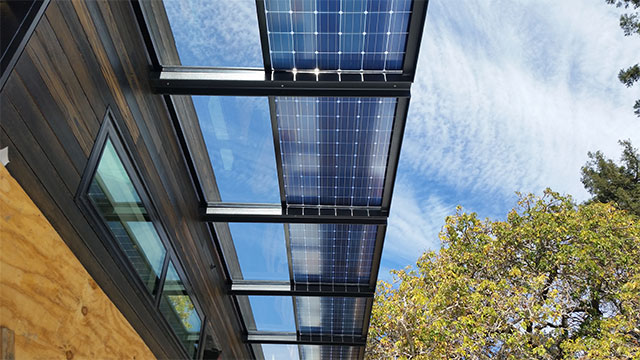What is a bifacial solar cell? What are the advantages?
Most of the solar panels you may have seen on residential roofs or solar fields are installed very tightly with high density on a general surface. It is a single-sided solar cell. Sunlight shines on the top of the panel and generates electricity.
But if you have enough space to spread those panels out a bit, to catch sunlight coming from different directions during the day, you can completely harvest twice the amount of energy, that is. is where this "bifacial" or "bilateral" solar panel comes into play.
What is the difference between bifacial solar cells?
"Monofacial" solar panels typically have an opaque back, designed to absorb and convert sunlight from one direction. In contrast, "bifacial" - 'two-sided' panels can absorb sunlight from both sides.
With double-sided solar panels, the back side will be transparent instead of opaque. This allows photons from reflected and diffused light to strike the back of the panel and generate electricity.
Bifacial panels can generate electricity from the sun shining directly on them and also from sunlight reflected on the opposite side or below the panel. In addition, diffused light from clouds, buildings or other objects can also shine in the background and generate electricity.

How much more energy can bifacial solar cells produce?
Like all solar systems, the exact amount of power you receive depends on the system's position and shape relative to the sun. In general, under similar conditions, double-sided panels can generate up to 30% more electricity than single-sided panels. Of course those are optimal conditions. Actual reality may be slightly different.
Because the second absorbing surface can capture light reflected from the ground and objects below the panel, they work better when installed on highly reflective objects. That is, highly reflective surfaces such as metal or snow. Or if your roof is highly reflective, that's also a great case for using double-sided panels.
Additionally, double-sided panels can also capture more light in low light conditions than single-sided panels. Therefore, this is a more optimal choice for places where sunlight may not be strong enough to use conventional single-sided panels.
Most bifacial panels use double-glass construction, making them stiffer and more resistant to degradation.
Disadvantages of double-sided panels
The main disadvantage of bifacial panels is that they are more expensive than conventional single-sided batteries. There are a few reasons for this, but mainly because bifacial panels tend to use more expensive monocrystalline photovoltaic cells than conventional panels. Add to that the additional hardware and materials, all of which drive up the cost.
To take advantage of reflected light, bifacial panels must be installed on supports from the ground or other surface they are mounted above. So that hardware increases the complexity of the installation and may not be suitable for a case. Panels also need to be carefully angled to take full advantage of direct, reflected and diffused sunlight for most of the day.

When should you use bifacial solar cells?
Whether bifacial solar panel technology is the right choice largely depends on the actual setup. If you have a lot of surface area for solar panels, then simply cover that area with cheaper single-sided panels. Conversely, in cases where space is limited, you may need the additional power production capacity of bifacial panels.
If you plan to install solar panels on metal supports on the ground, it makes sense to use double-sided panels to capture as much sunlight as possible, especially on surfaces with high reflectivity.
You should read it
- What is solar storm? How solar storm affects the Earth
- Solar wireless headphones
- Engineers reveal batteries from new algae with many advantages
- Successfully developed 'indoor solar cells' with conversion efficiency up to 37%
- Kvaern electronic bicycle can run on solar energy
- The first solar street in the world went into operation in Normandy, France
 Meta 'death' of CrowdTangle, tool to track false information
Meta 'death' of CrowdTangle, tool to track false information Top 8 best Oppo phones in 2024
Top 8 best Oppo phones in 2024 How to delete links in Excel, delete hyperlinks in Excel
How to delete links in Excel, delete hyperlinks in Excel How to use Reduce interruption mode on iPhone
How to use Reduce interruption mode on iPhone Opera One is now available on iPhone
Opera One is now available on iPhone How to open Task Manager on Mac
How to open Task Manager on Mac